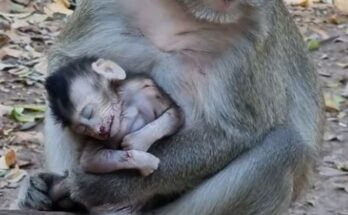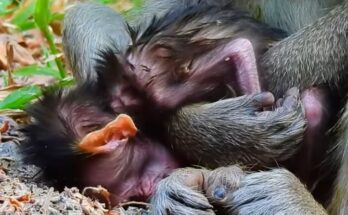In the ever-growing intersection between wildlife and human development, one tragic scene plays out all too often: a monkey, injured and trembling, lies beneath a power line, the victim of an electric shock. As cities expand and natural habitats shrink, wild animals are forced to navigate increasingly dangerous urban environments—and the consequences can be deadly. The story of an electrocuted monkey is not just a moment of suffering; it’s a stark reminder of the hidden perils that urbanization brings to wildlife.
The monkey, likely part of a troop that roams the outskirts of a city, was simply doing what monkeys do—climbing, exploring, searching for food. In its natural habitat, trees serve as both highway and home. But in cities, monkeys adapt by using electrical wires, poles, and buildings as substitutes. Unfortunately, these modern structures were never meant for wild limbs and curious hands.
One wrong move is all it takes. As the monkey reached out to swing from one wire to another, it accidentally completed a circuit—sending a powerful jolt of electricity through its small body. The shock was immediate and excruciating. Observers reported the monkey screaming, convulsing, and falling to the ground, its fur singed and limbs spasming. Even if the monkey survives the initial electrocution, the aftereffects can be devastating: burns, nerve damage, internal injuries, and often, long-term disability.
This tragic incident is not rare. Across many countries, especially in rapidly urbanizing regions of Asia and Africa, monkeys and other wildlife are electrocuted with alarming frequency. Power infrastructure—open transformers, uninsulated wires, and low-hanging cables—creates a deadly maze for animals that evolved to swing freely through the treetops. For many monkeys, especially species like macaques and langurs that are highly adaptable and increasingly urban, the risk is part of daily life.
The injuries from electrical shocks are just one of many urban threats these animals face. Monkeys in cities are also exposed to traffic accidents, pollution, aggressive dogs, and even human violence. While some city dwellers show compassion and provide food or rescue assistance, others see monkeys as pests—invading homes, stealing food, or creating messes. This often results in human-monkey conflict, further endangering the animals.
However, the story of the electrocuted monkey has inspired some efforts toward change. Animal rescue teams and wildlife organizations have begun lobbying for safer power line designs, better insulation, and the planting of tree corridors to provide alternative travel routes for monkeys. In some cities, conservationists work with local governments to identify high-risk areas and implement monkey-safe infrastructure—small but crucial steps toward coexistence.
Yet much more needs to be done. As urban areas continue to sprawl into natural habitats, we must recognize the responsibility that comes with that expansion. Animals like monkeys don’t choose to live among humans—they are driven there by necessity. Their pain, like that of the injured monkey writhing from an electric shock, is a direct consequence of our changing world.
This haunting scene urges us to rethink how cities grow—and how we can make them safer not just for people, but for the animals forced to share them. Would you like this expanded into an op-ed or paired with statistics and real-life case studies?


